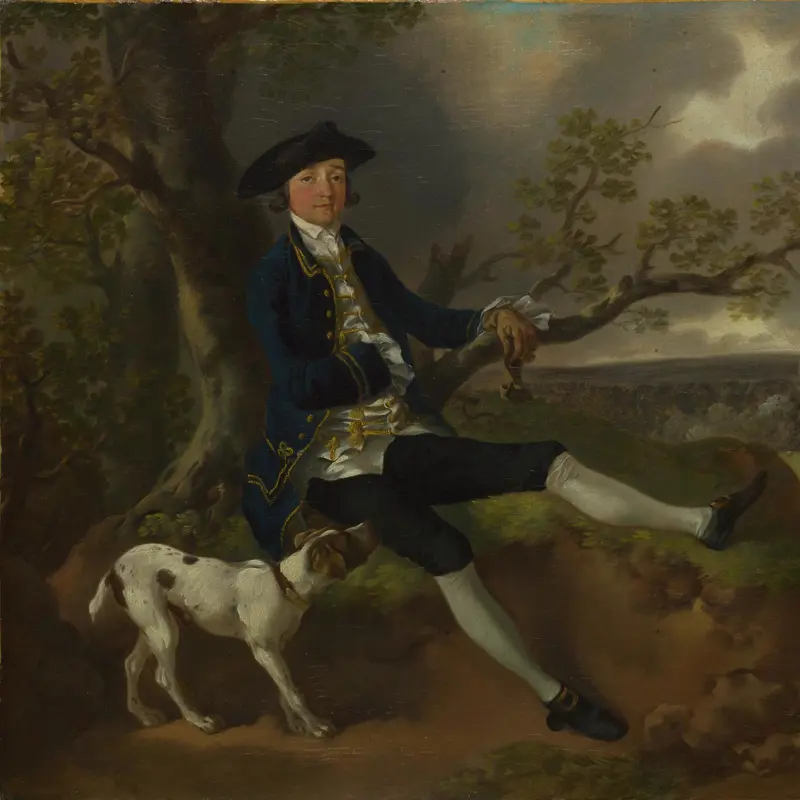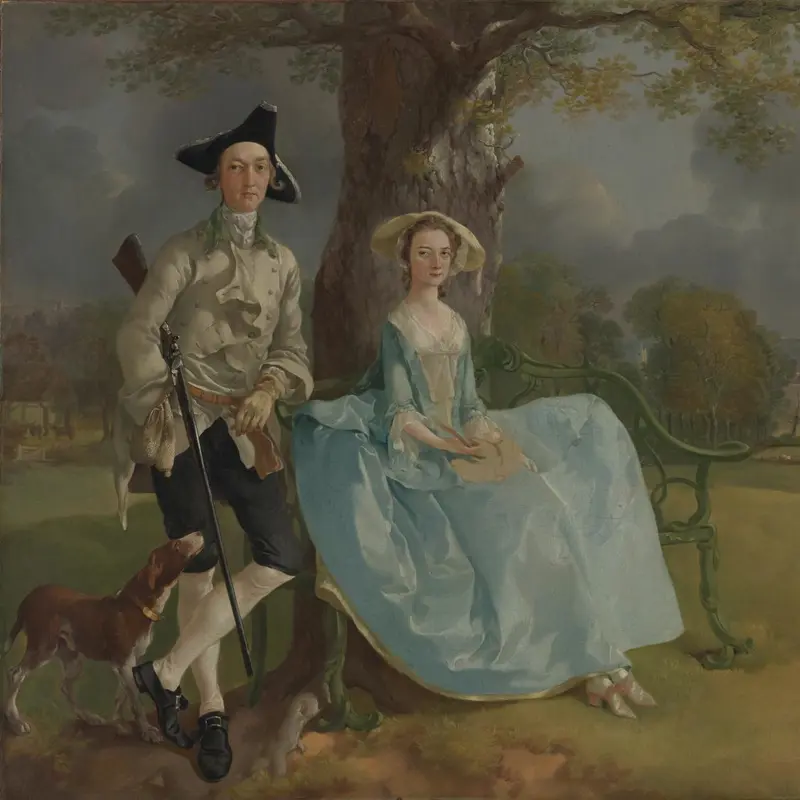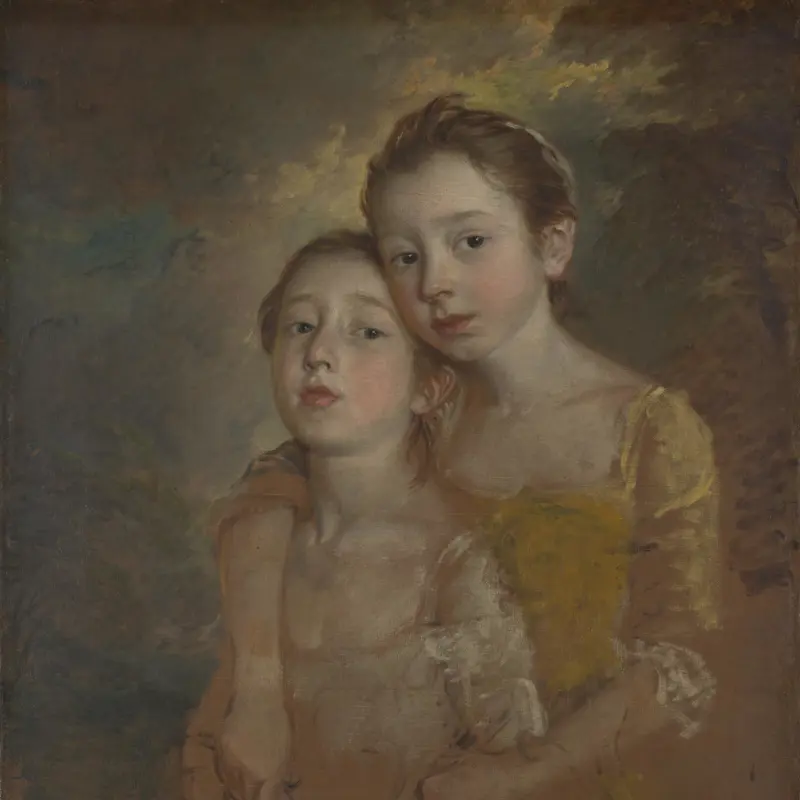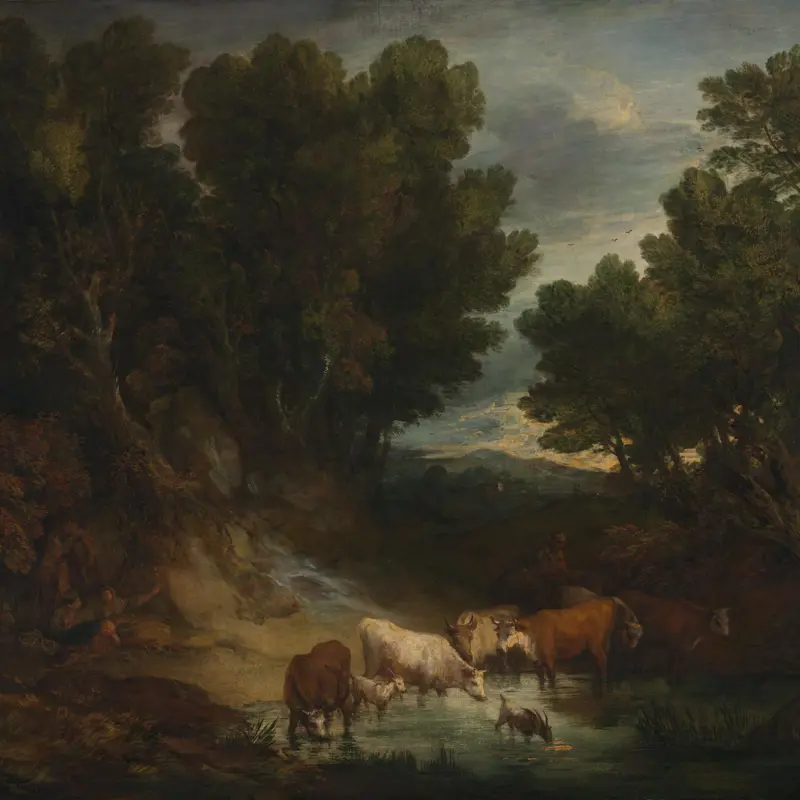Thomas Gainsborough, 'Cornard Wood, near Sudbury, Suffolk', 1748
About the work
Overview
Cornard Wood is on the outskirts of the village of Great Cornard, two miles from Sudbury, where Gainsborough was born. The view is taken from Abbas Hall, looking towards the village of Great Henny. The church of St Mary’s Great Henny appears in the background, our eyes led to it by the path winding through the wood.
Cornard Wood was common land, and villagers had ancient rights to gather wood, graze animals, dig marl for manure and sand for building materials, take the path to Great Henny, or just to stroll there. In Gainsborough’s painting we see many of these activities.
Gainsborough wrote that Cornard Wood was ‘actually painted at Sudbury, in the year 1748’, while he was still learning his craft. The picture belonged for some years to the uncle of the painter John Constable, who was born within ten miles of Gainsborough’s birthplace and was an admirer of his landscapes.
Key facts
Details
- Full title
- Cornard Wood, near Sudbury, Suffolk
- Artist
- Thomas Gainsborough
- Artist dates
- 1727 - 1788
- Date made
- 1748
- Medium and support
- Oil on canvas
- Dimensions
- 122 × 155 cm
- Acquisition credit
- Bought (Lewis Fund), 1875
- Inventory number
- NG925
- Location
- Room 34
- Collection
- Main Collection
- Frame
- 19th-century English Frame
Provenance
Additional information
Text extracted from the ‘Provenance’ section of the catalogue entry in Judy Egerton, ‘National Gallery Catalogues: The British Paintings’, London 2000; for further information, see the full catalogue entry.
Exhibition history
-
2021The Young Gainsborough: Rediscovered Landscape DrawingsYork Art Gallery1 October 2021 - 13 February 2022National Gallery of Ireland5 March 2022 - 12 June 2022Nottingham Castle Museum and Art Gallery2 July 2022 - 13 November 2022
-
2024Discover Constable and The Hay WainThe National Gallery (London)17 October 2024 - 2 February 2025
Bibliography
-
1856G.W. Fulcher, Life of Thomas Gainsborough, R.A., London 1856
-
1915W.T. Whitley, Thomas Gainsborough, London 1915
-
1934R. Fry, Reflections on British Painting, London 1934
-
1935M. Woodall, 'A Note on Gainsborough and Ruisdael', The Burlington Magazine, LXVI, 1935, pp. 40-5
-
1939M. Woodall, Gainsborough's Landscape Drawings, London 1939
-
1946Davies, Martin, National Gallery Catalogues: British School, London 1946
-
1953E.K. Waterhouse, Painting in Britain 1530-1790, London 1953
-
1955H.V.S. Ogden and M.S. Ogden, English Taste in Landscape in the Seventeeth Century, Ann Arbor 1955
-
1959Davies, Martin, National Gallery Catalogues: British School, 2nd edn (revised), London 1959
-
1976H. Potterton, Reynolds and Gainsborough, Themes and Painters in the National Gallery 2, London 1976
-
1982J.T. Hayes, The Landscape Paintings of Thomas Gainsborough: A Critical Text and Catalogue Raisonné, Ithaca 1982
-
1985M. Rosenthal, 'The Landscape Moralised in Mid Eighteenth Century Britain', Australian Journal of Art, IV, 1985, pp. 36-49
-
1988A. Moore, Dutch and Flemish Painting in Norfolk: A History of Taste and Influence, Fashion and Collecting (exh. cat. Norwich Castle Museum & Art Gallery, 10 September - 20 November 1988), London 1988
-
1990M. Cormack, 'An Early Landscape by Gainsborough for Gainsborough's House', Gainsborough's House Society Annual Report, 1990, pp. 30-7
-
1991M. Cormack, The Paintings of Thomas Gainsborough, Cambridge 1991
-
1991E.J. Walford, Jacob van Ruisdael, New Haven 1991
-
1997M. Rosenthal (ed.), Prospects for the Nation: Recent Essays in British Landscape, 1750 1880, New Haven 1997
-
1997A. Asfour, P. Williamson and G. Jackson, '"A Second Sentimental Journey": Gainsborough Abroad', Apollo, CXLVI, 1997, pp. 27-30
-
1997S. Foister, 'Young Gainsborough and the English Taste for Dutch Landscape', Apollo, CXLVI/426, 1997, pp. 3-11
-
1998J. Egerton, The British School, London 1998
-
2000Egerton, Judy, National Gallery Catalogues: The British Paintings, revised edn, London 2000
-
2001
C. Baker and T. Henry, The National Gallery: Complete Illustrated Catalogue, London 2001
Frame
This frame is probably a replica of an eighteenth-century English frame. Oil-gilded, it is constructed from pine. The back edge showcases a stylised semi-flower and leaf motif, the corner cartouches are adorned with flower heads, and the centre cartouches feature a shell motif surrounded by flowers and foliage. The playful, swept outline is stepped and sweeps into scrolls with pierced centres. Raking gadroons are positioned before a sanded flat. The sight moulding is embellished with an acanthus-leaf-and-shell motif. The painting was reframed after 1935 and its English Rococo style is consistent with the original frames often found on Gainsborough’s earlier works.
About this record
If you know more about this work or have spotted an error, please contact us. Please note that exhibition histories are listed from 2009 onwards. Bibliographies may not be complete; more comprehensive information is available in the National Gallery Library.















